check engine HYUNDAI I20 2021 Service Manual
[x] Cancel search | Manufacturer: HYUNDAI, Model Year: 2021, Model line: I20, Model: HYUNDAI I20 2021Pages: 444, PDF Size: 8.93 MB
Page 321 of 444
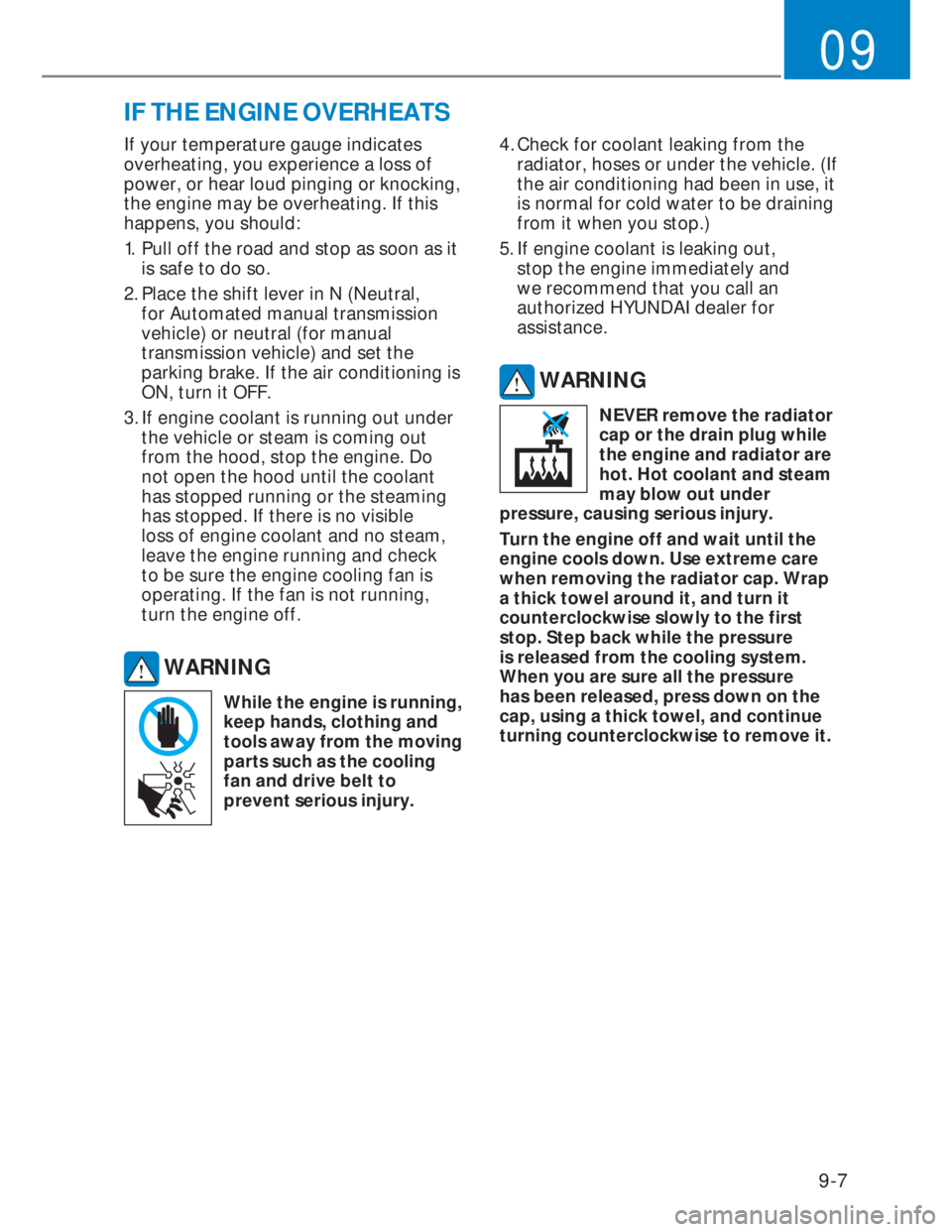
9-7
09
If your temperature gauge indicates
overheating, you experience a loss of
power, or hear loud pinging or knocking,
the engine may be overheating. If this
happens, you should:
1. Pull off the road and stop as soon as it
is safe to do so.
2. Place the shift lever in N (Neutral,
for Automated manual transmission
vehicle) or neutral (for manual
transmission vehicle) and set the
parking brake. If the air conditioning is
ON, turn it OFF.
3. If engine coolant is running out under
the vehicle or steam is coming out
from the hood, stop the engine. Do
not open the hood until the coolant
has stopped running or the steaming
has stopped. If there is no visible
loss of engine coolant and no steam,
leave the engine running and check
to be sure the engine cooling fan is
operating. If the fan is not running,
turn the engine off.
WARNING
While the engine is running,
keep hands, clothing and
tools away from the moving
parts such as the cooling
fan and drive belt to
prevent serious injury.4. Check for coolant leaking from the
radiator, hoses or under the vehicle. (If
the air conditioning had been in use, it
is normal for cold water to be draining
from it when you stop.)
5. If engine coolant is leaking out,
stop the engine immediately and
we recommend that you call an
authorized HYUNDAI dealer for
assistance.
WARNING
NEVER remove the radiator
cap or the drain plug while
the engine and radiator are
hot. Hot coolant and steam
may blow out under
pressure, causing serious injury.
Turn the engine off and wait until the
engine cools down. Use extreme care
when removing the radiator cap. Wrap
a thick towel around it, and turn it
counterclockwise slowly to the first
stop. Step back while the pressure
is released from the cooling system.
When you are sure all the pressure
has been released, press down on the
cap, using a thick towel, and continue
turning counterclockwise to remove it.
IF THE ENGINE OVERHEATS
Page 322 of 444
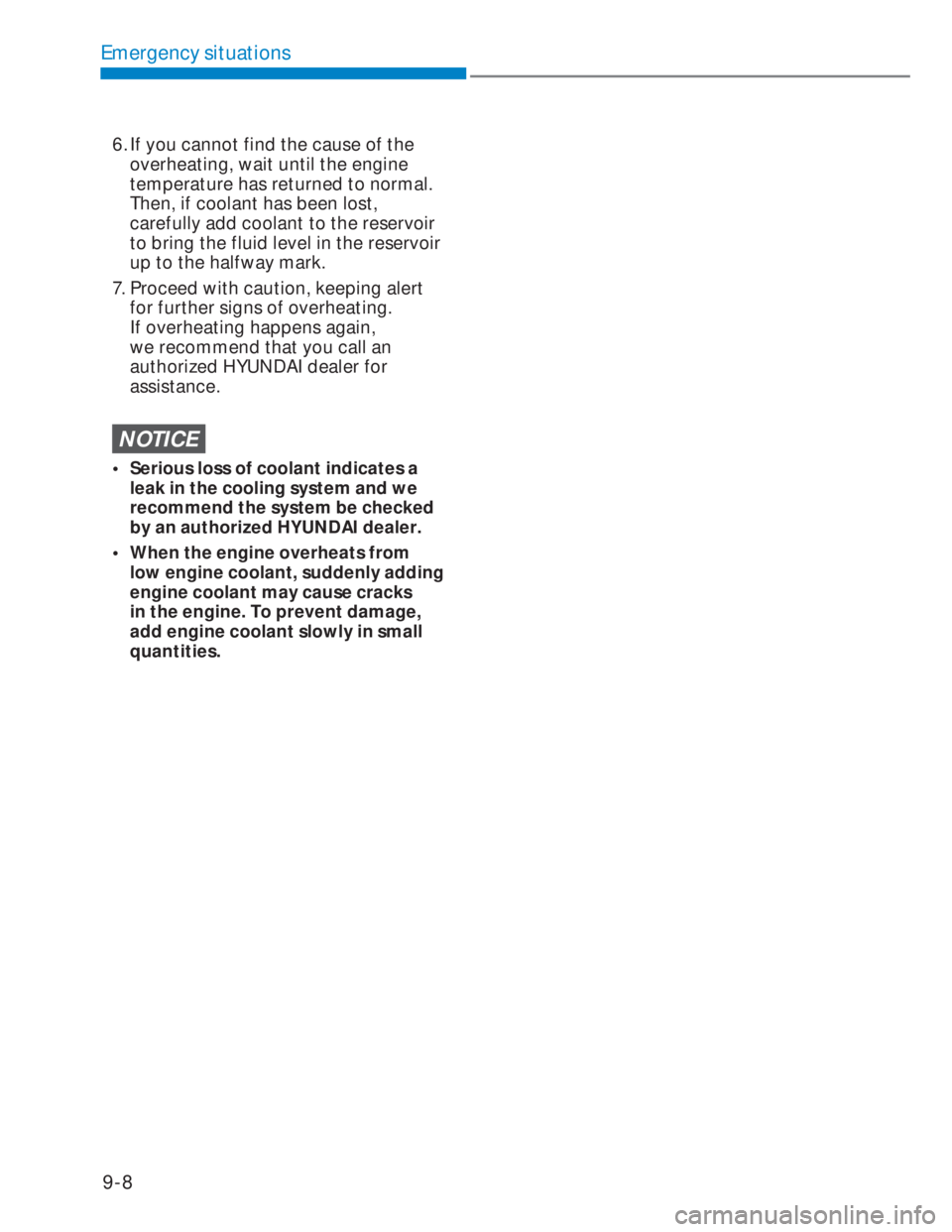
9-8
Emergency situations
6. If you cannot find the cause of the
overheating, wait until the engine
temperature has returned to normal.
Then, if coolant has been lost,
carefully add coolant to the reservoir
to bring the fluid level in the reservoir
up to the halfway mark.
7. Proceed with caution, keeping alert
for further signs of overheating.
If overheating happens again,
we recommend that you call an
authorized HYUNDAI dealer for
assistance.
NOTICE
• Serious loss of coolant indicates a
leak in the cooling system and we
recommend the system be checked
by an authorized HYUNDAI dealer.
• When the engine overheats from
low engine coolant, suddenly adding
engine coolant may cause cracks
in the engine. To prevent damage,
add engine coolant slowly in small
quantities.
Page 324 of 444
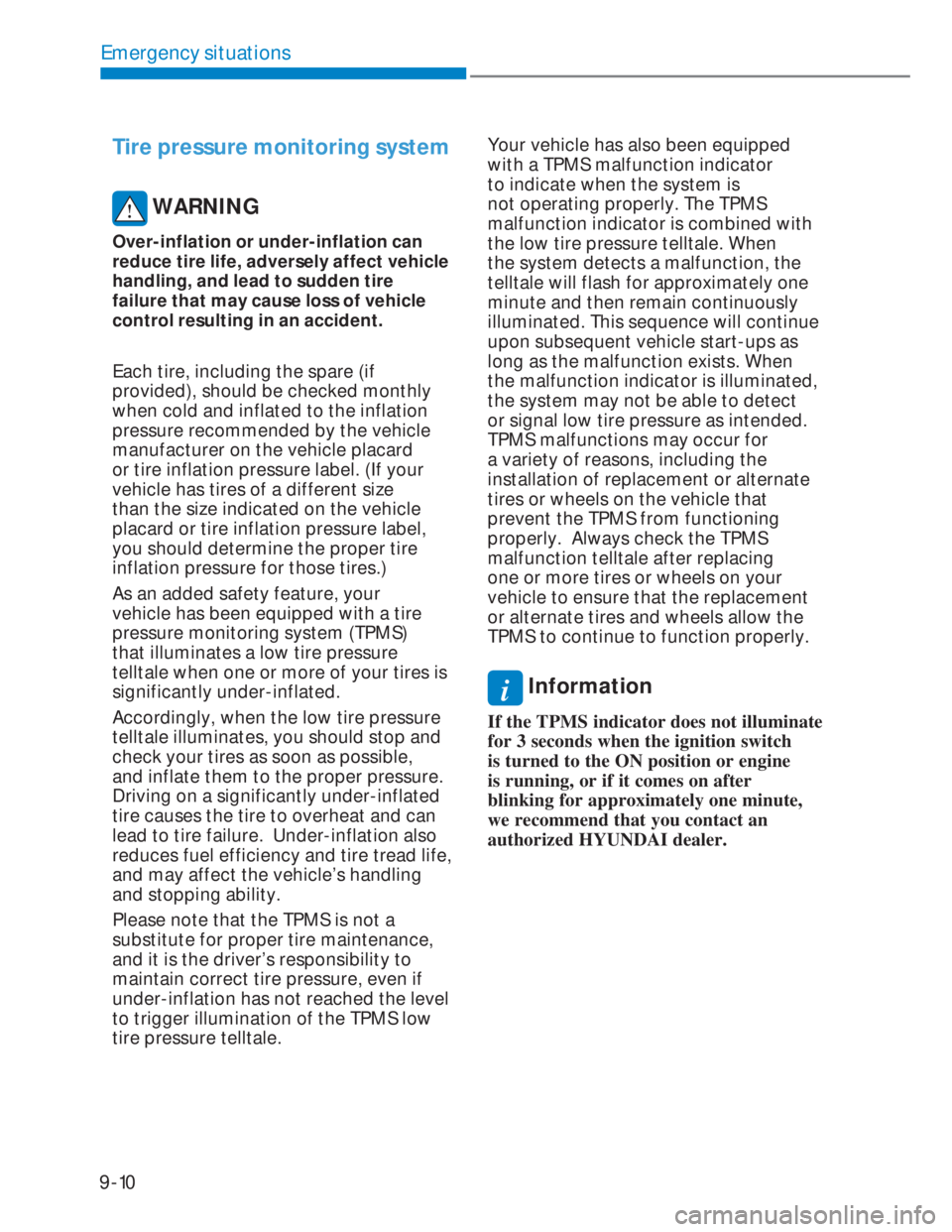
9-10
Emergency situations
Tire pressure monitoring system
WARNING
Over-inflation or under-inflation can
reduce tire life, adversely affect vehicle
handling, and lead to sudden tire
failure that may cause loss of vehicle
control resulting in an accident.
Each tire, including the spare (if
provided), should be checked monthly
when cold and inflated to the inflation
pressure recommended by the vehicle
manufacturer on the vehicle placard
or tire inflation pressure label. (If your
vehicle has tires of a different size
than the size indicated on the vehicle
placard or tire inflation pressure label,
you should determine the proper tire
inflation pressure for those tires.)
As an added safety feature, your
vehicle has been equipped with a tire
pressure monitoring system (TPMS)
that illuminates a low tire pressure
telltale when one or more of your tires is
significantly under-inflated.
Accordingly, when the low tire pressure
telltale illuminates, you should stop and
check your tires as soon as possible,
and inflate them to the proper pressure.
Driving on a significantly under-inflated
tire causes the tire to overheat and can
lead to tire failure. Under-inflation also
reduces fuel efficiency and tire tread life,
and may affect the vehicle’s handling
and stopping ability.
Please note that the TPMS is not a
substitute for proper tire maintenance,
and it is the driver’s responsibility to
maintain correct tire pressure, even if
under-inflation has not reached the level
to trigger illumination of the TPMS low
tire pressure telltale.Your vehicle has also been equipped
with a TPMS malfunction indicator
to indicate when the system is
not operating properly. The TPMS
malfunction indicator is combined with
the low tire pressure telltale. When
the system detects a malfunction, the
telltale will flash for approximately one
minute and then remain continuously
illuminated. This sequence will continue
upon subsequent vehicle start-ups as
long as the malfunction exists. When
the malfunction indicator is illuminated,
the system may not be able to detect
or signal low tire pressure as intended.
TPMS malfunctions may occur for
a variety of reasons, including the
installation of replacement or alternate
tires or wheels on the vehicle that
prevent the TPMS from functioning
properly. Always check the TPMS
malfunction telltale after replacing
one or more tires or wheels on your
vehicle to ensure that the replacement
or alternate tires and wheels allow the
TPMS to continue to function properly.
i Information
If the TPMS indicator does not illuminate
for 3 seconds when the ignition switch
is turned to the ON position or engine
is running, or if it comes on after
blinking for approximately one minute,
we recommend that you contact an
authorized HYUNDAI dealer.
Page 340 of 444
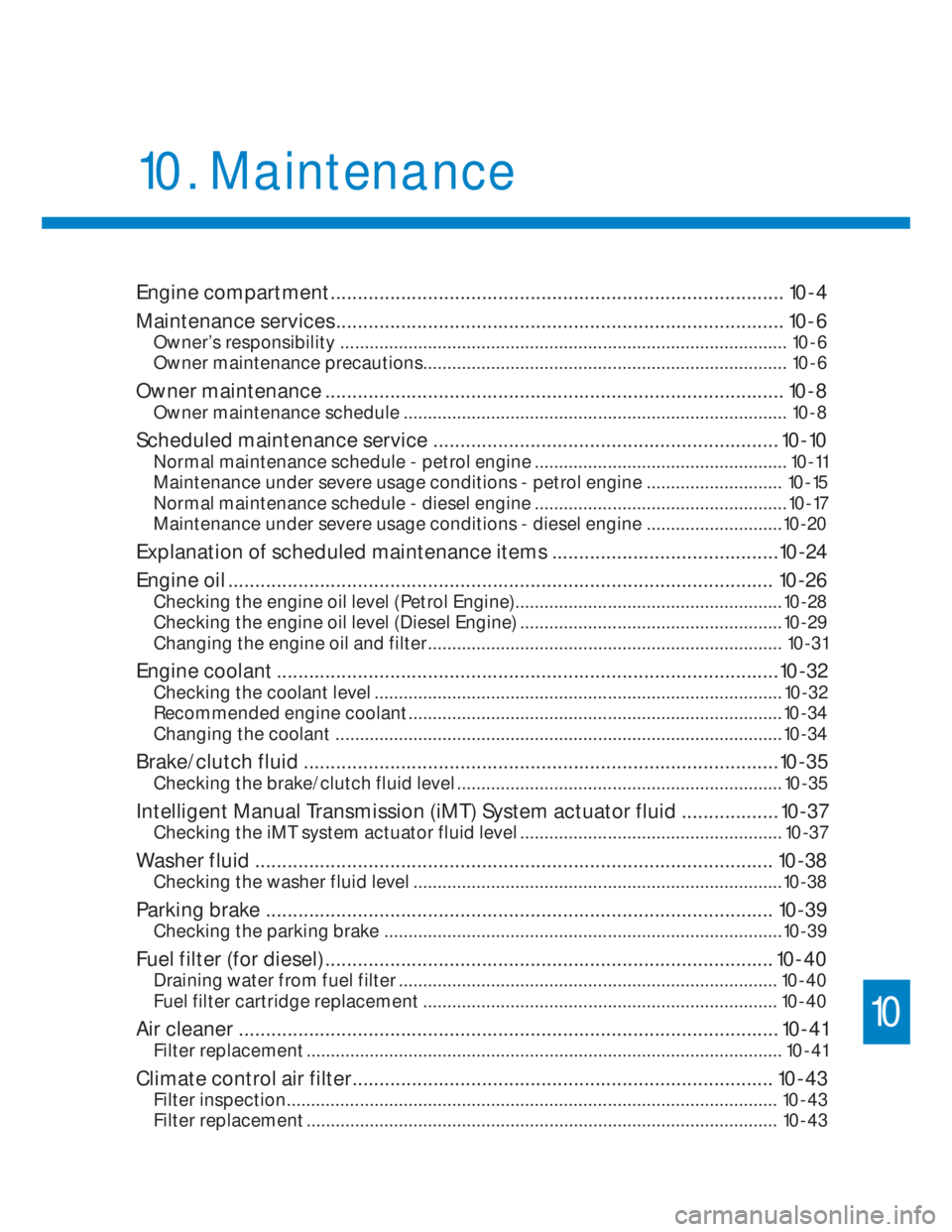
Engine compartment .................................................................................... 10-4
Maintenance services
................................................................................... 10-6
Owner’s responsibility ............................................................................................ 10-6
Owner maintenance precautions........................................................................... 10-6
Owner maintenance ..................................................................................... 10-8
Owner maintenance schedule ............................................................................... 10-8
Scheduled maintenance service ................................................................ 10-10
Normal maintenance schedule - petrol engine .................................................... 10-11
Maintenance under severe usage conditions - petrol engine
............................ 10-15
Normal maintenance schedule - diesel engine ....................................................10-17
Maintenance under severe usage conditions - diesel engine ............................10-20
Explanation of scheduled maintenance items ..........................................10-24
Engine oil
..................................................................................................... 10-26
Checking the engine oil level (Petrol Engine) .......................................................10-28
Checking the engine oil level (Diesel Engine) ......................................................10-29
Changing the engine oil and filter
......................................................................... 10-31
Engine coolant .............................................................................................10-32
Checking the coolant level .................................................................................... 10-32
Recommended engine coolant .............................................................................10-34
Changing the coolant
............................................................................................10-34
Brake/clutch fluid ........................................................................................10-35
Checking the brake/clutch fluid level ................................................................... 10-35
Intelligent Manual Transmission (iMT) System actuator fluid .................. 10-37
Checking the iMT system actuator fluid level ...................................................... 10-37
Washer fluid ................................................................................................ 10-38
Checking the washer fluid level ............................................................................10-38
Parking brake .............................................................................................. 10-39
Checking the parking brake ..................................................................................10-39
Fuel filter (for diesel) ................................................................................... 10-40
Draining water from fuel filter .............................................................................. 10-40
Fuel filter cartridge replacement
......................................................................... 10-40
Air cleaner .................................................................................................... 10-41
Filter replacement .................................................................................................. 10-41
Climate control air filter.............................................................................. 10-43
Filter inspection ..................................................................................................... 10-43
Filter replacement ................................................................................................. 10-43
10. Maintenance
10
Page 341 of 444
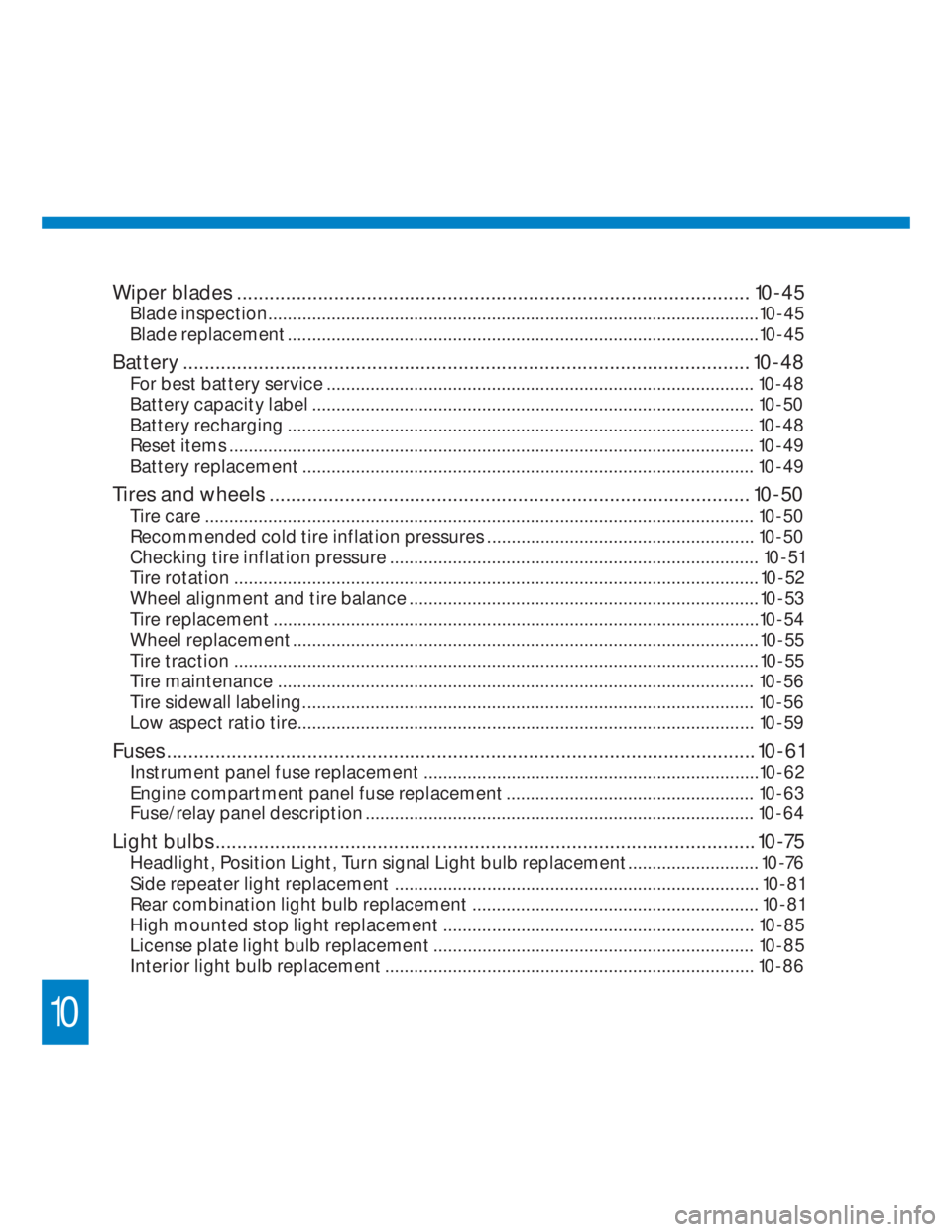
10
Wiper blades ............................................................................................... 10-45
Blade inspection .....................................................................................................10-45
Blade replacement .................................................................................................10-45
Battery ......................................................................................................... 10-48
For best battery service ........................................................................................ 10-48
Battery capacity label
........................................................................................... 10-50
Battery recharging ................................................................................................ 10-48
Reset items ............................................................................................................ 10-49
Battery replacement
............................................................................................. 10-49
Tires and wheels ......................................................................................... 10-50
Tire care ................................................................................................................. 10-50
Recommended cold tire inflation pressures ....................................................... 10-50
Checking tire inflation pressure
............................................................................ 10-51
Tire rotation
............................................................................................................10-52
Wheel alignment and tire balance ........................................................................10-53
Tire replacement ....................................................................................................10-54
Wheel replacement
................................................................................................10-55
Tire traction
............................................................................................................10-55
Tire maintenance .................................................................................................. 10-56
Tire sidewall labeling ............................................................................................. 10-56
Low aspect ratio tire.............................................................................................. 10-59
Fuses ............................................................................................................. 10-61
Instrument panel fuse replacement .....................................................................10-62
Engine compartment panel fuse replacement ................................................... 10-63
Fuse/relay panel description
................................................................................ 10-64
Light bulbs .................................................................................................... 10-75
Headlight, Position Light, Turn signal Light bulb replacement ........................... 10-76
Side repeater light replacement ........................................................................... 10-81
Rear combination light bulb replacement
........................................................... 10-81
High mounted stop light replacement ................................................................ 10-85
License plate light bulb replacement .................................................................. 10-85
Interior light bulb replacement ............................................................................ 10-86
Page 346 of 444
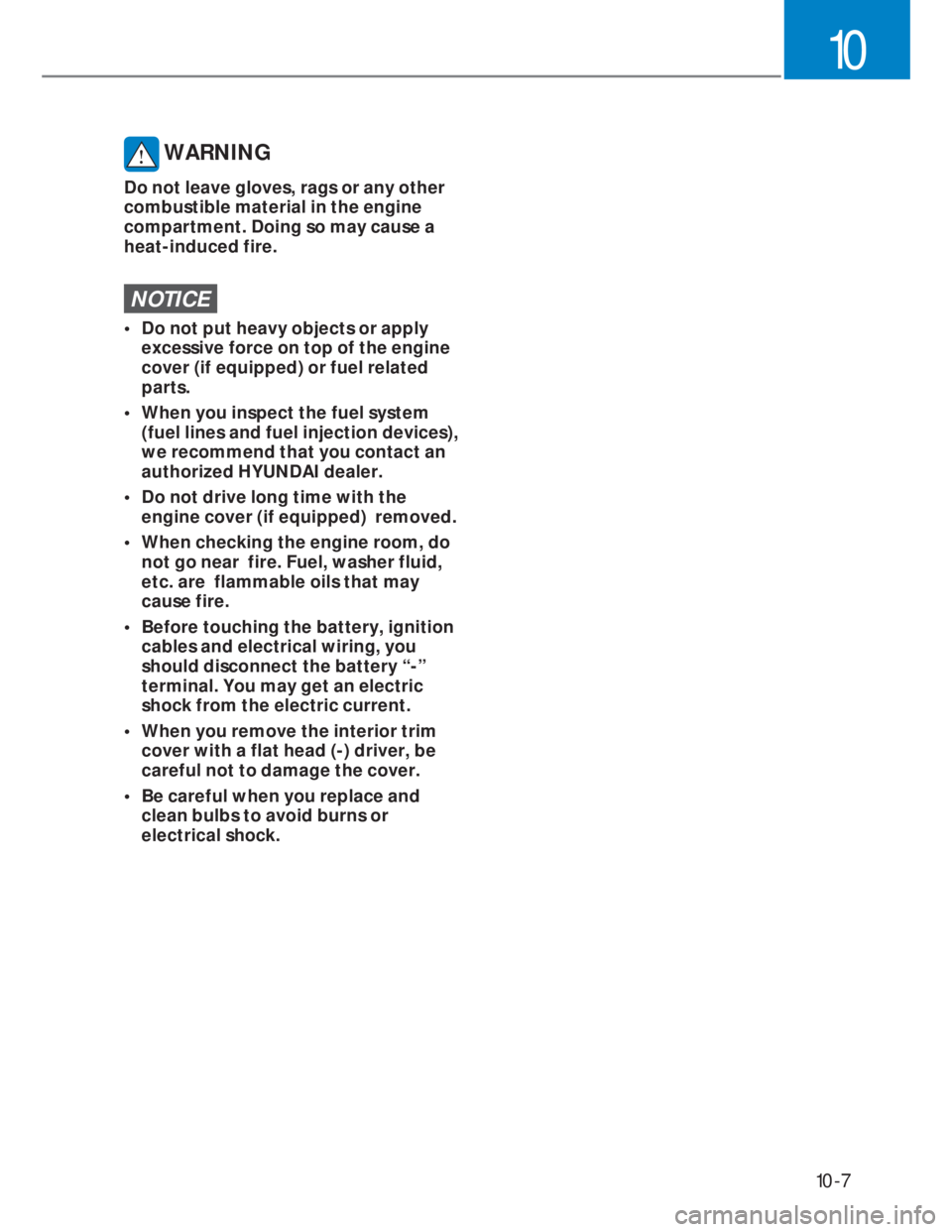
10-7
10
WARNING
Do not leave gloves, rags or any other
combustible material in the engine
compartment. Doing so may cause a
heat-induced fire.
NOTICE
• Do not put heavy objects or apply
excessive force on top of the engine
cover (if equipped) or fuel related
parts.
• When you inspect the fuel system
(fuel lines and fuel injection devices),
we recommend that you contact an
authorized HYUNDAI dealer.
• Do not drive long time with the
engine cover (if equipped) removed.
• When checking the engine room, do
not go near fire. Fuel, washer fluid,
etc. are flammable oils that may
cause fire.
• Before touching the battery, ignition
cables and electrical wiring, you
should disconnect the battery “-”
terminal. You may get an electric
shock from the electric current.
• When you remove the interior trim
cover with a flat head (-) driver, be
careful not to damage the cover.
• Be careful when you replace and
clean bulbs to avoid burns or
electrical shock.
Page 347 of 444
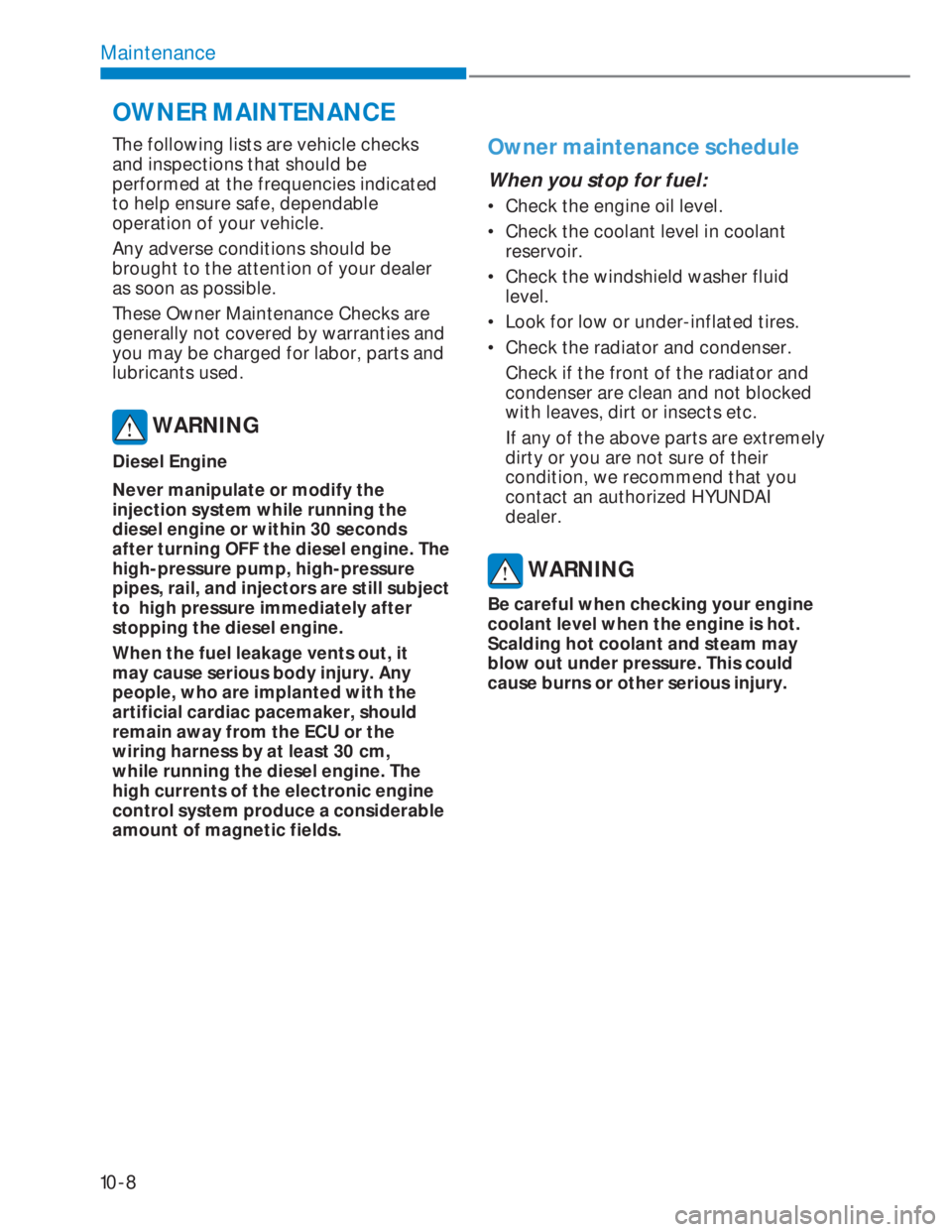
10-8
Maintenance
The following lists are vehicle checks
and inspections that should be
performed at the frequencies indicated
to help ensure safe, dependable
operation of your vehicle.
Any adverse conditions should be
brought to the attention of your dealer
as soon as possible.
These Owner Maintenance Checks are
generally not covered by warranties and
you may be charged for labor, parts and
lubricants used.
WARNING
Diesel Engine
Never manipulate or modify the
injection system while running the
diesel engine or within 30 seconds
after turning OFF the diesel engine. The
high-pressure pump, high-pressure
pipes, rail, and injectors are still subject
to high pressure immediately after
stopping the diesel engine.
When the fuel leakage vents out, it
may cause serious body injury. Any
people, who are implanted with the
artificial cardiac pacemaker, should
remain away from the ECU or the
wiring harness by at least 30 cm,
while running the diesel engine. The
high currents of the electronic engine
control system produce a considerable
amount of magnetic fields.
Owner maintenance schedule
When you stop for fuel:
• Check the engine oil level.
• Check the coolant level in coolant
reservoir.
• Check the windshield washer fluid
level.
• Look for low or under-inflated tires.
• Check the radiator and condenser.
Check if the front of the radiator and
condenser are clean and not blocked
with leaves, dirt or insects etc.
If any of the above parts are extremely
dirty or you are not sure of their
condition, we recommend that you
contact an authorized HYUNDAI
dealer.
WARNING
Be careful when checking your engine
coolant level when the engine is hot.
Scalding hot coolant and steam may
blow out under pressure. This could
cause burns or other serious injury.
OWNER MAINTENANCE
Page 348 of 444
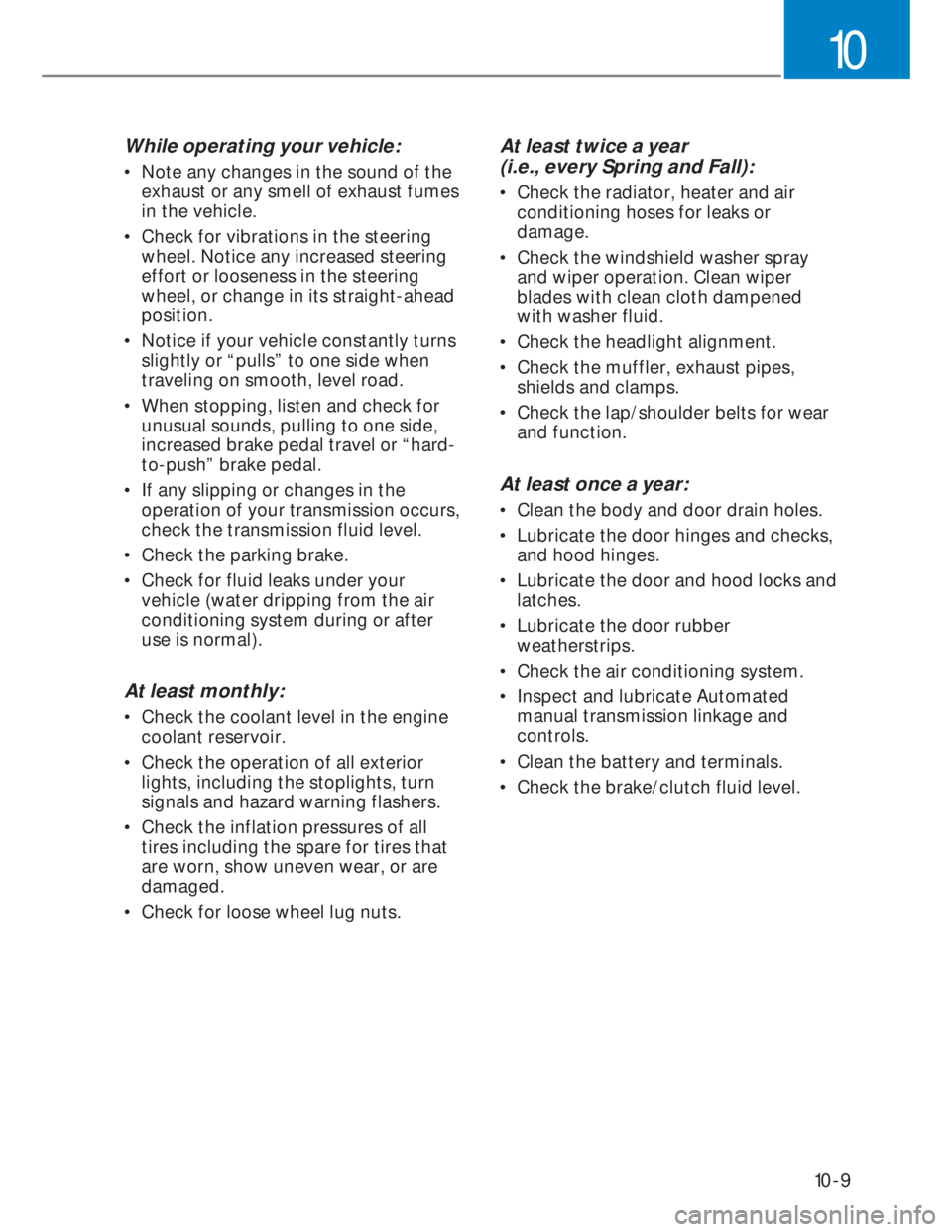
10-9
10
While operating your vehicle:
• Note any changes in the sound of the
exhaust or any smell of exhaust fumes
in the vehicle.
• Check for vibrations in the steering
wheel. Notice any increased steering
effort or looseness in the steering
wheel, or change in its straight-ahead
position.
• Notice if your vehicle constantly turns
slightly or “pulls” to one side when
traveling on smooth, level road.
• When stopping, listen and check for
unusual sounds, pulling to one side,
increased brake pedal travel or “hard-
to-push” brake pedal.
• If any slipping or changes in the
operation of your transmission occurs,
check the transmission fluid level.
• Check the parking brake.
• Check for fluid leaks under your
vehicle (water dripping from the air
conditioning system during or after
use is normal).
At least monthly:
• Check the coolant level in the engine
coolant reservoir.
• Check the operation of all exterior
lights, including the stoplights, turn
signals and hazard warning flashers.
• Check the inflation pressures of all
tires including the spare for tires that
are worn, show uneven wear, or are
damaged.
• Check for loose wheel lug nuts.
At least twice a year
(i.e., every Spring and Fall):
• Check the radiator, heater and air
conditioning hoses for leaks or
damage.
• Check the windshield washer spray
and wiper operation. Clean wiper
blades with clean cloth dampened
with washer fluid.
• Check the headlight alignment.
• Check the muffler, exhaust pipes,
shields and clamps.
• Check the lap/shoulder belts for wear
and function.
At least once a year:
• Clean the body and door drain holes.
• Lubricate the door hinges and checks,
and hood hinges.
• Lubricate the door and hood locks and
latches.
• Lubricate the door rubber
weatherstrips.
• Check the air conditioning system.
• Inspect and lubricate Automated
manual transmission linkage and
controls.
• Clean the battery and terminals.
• Check the brake/clutch fluid level.
Page 352 of 444
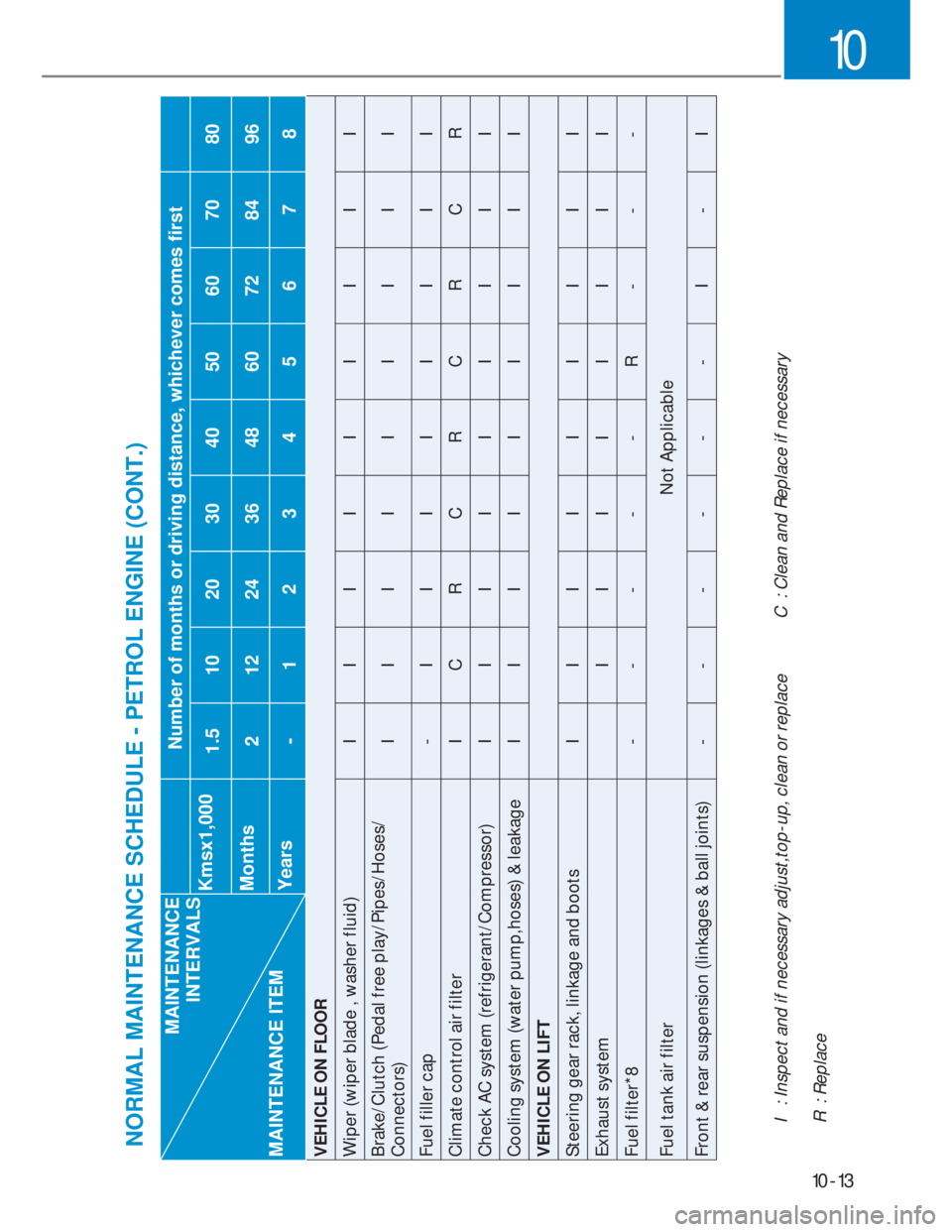
10-13
10
MAINTENANCE
INTERVALS
MAINTENANCE ITEMNumber of months or driving distance, whichever comes first
Kmsx1,000
1.51020304050607080
Months
2 1224364860728496
Years
- 12345678
VEHICLE ON FLOOR
Wiper (wiper blade , washer fluid) I IIIIIIII
Brake/Clutch (Pedal free play/Pipes/Hoses/
Connectors)IIIIIIIII
Fuel filler cap -IIIIIIII
Climate control air filter I C R C R C R C R
Check AC system (refrigerant/Compressor) I IIIIIIII
Cooling system (water pump,hoses) & leakage I I IIIIIII
VEHICLE ON LIFT
Steering gear rack, linkage and bootsIIIIIIIII
Exhaust systemIIIIIIII
Fuel filter*8-----R---
Fuel tank air filter Not Applicable
Front & rear suspension (linkages & ball joints)------
I-I
I : Inspect and if necessary adjust,top-up, clean or replace
R : ReplaceC : Clean and Replace if necessaryNORMAL MAINTENANCE SCHEDULE - PETROL ENGINE (CONT.)
Page 353 of 444
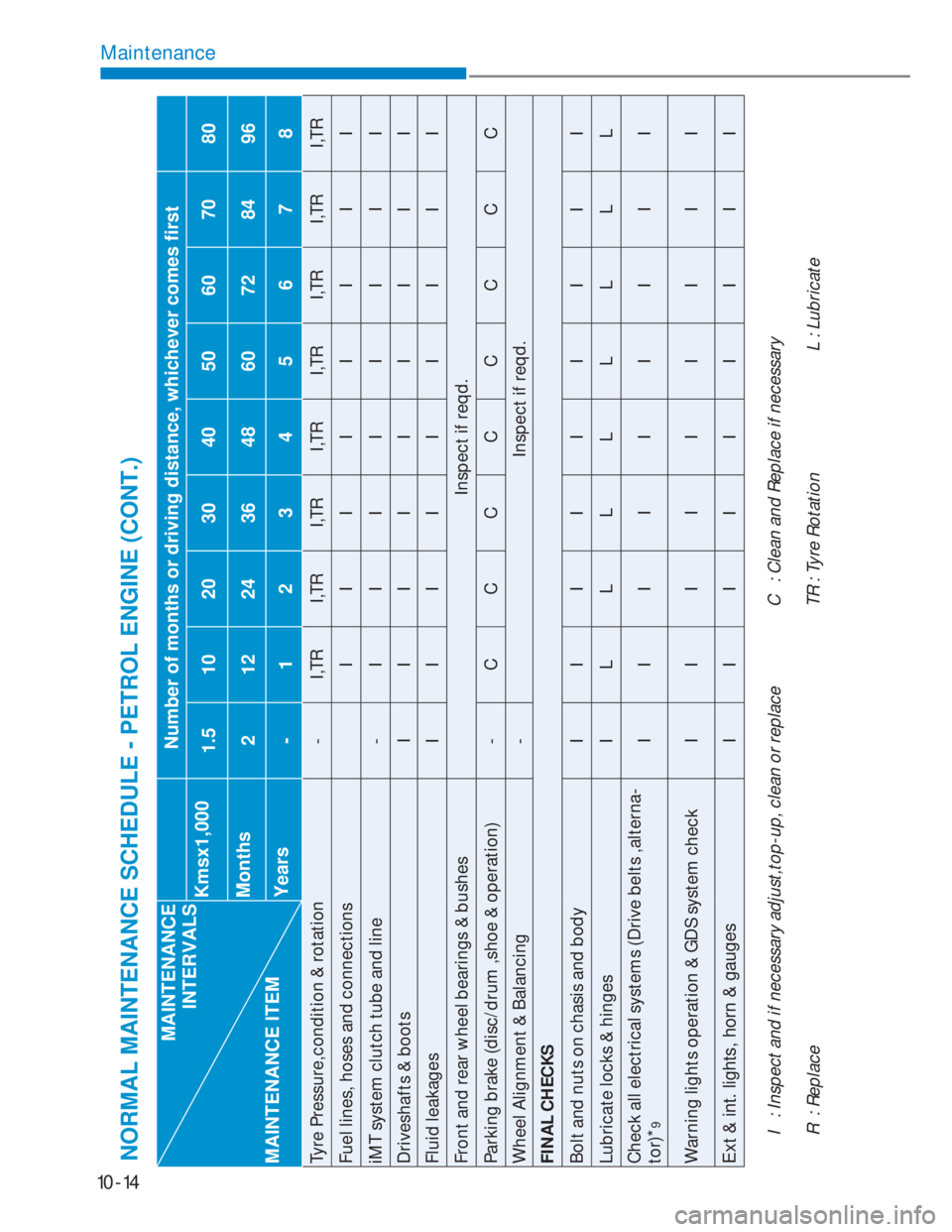
10-14
Maintenance
MAINTENANCE
INTERVALS
MAINTENANCE ITEMNumber of months or driving distance, whichever comes first
Kmsx1,000
1.51020304050607080
Months
2 1224364860728496
Years
- 12345678
Tyre Pressure,condition & rotation - I,TR I,TR I,TR I,TR I,TR I,TR I,TR I,TR
Fuel lines, hoses and connections IIIIIIII
iMT system clutch tube and line - I IIIIIII
Driveshafts & bootsIIIIIIIII
Fluid leakages IIIIIIIII
Front and rear wheel bearings & bushes Inspect if reqd.
Parking brake (disc/drum ,shoe & operation) - CCCCCCCC
Wheel Alignment & Balancing - Inspect if reqd.
FINAL CHECKS
Bolt and nuts on chasis and body I I IIIIIII
Lubricate locks & hinges ILLLLLLLL
Check all electrical systems (Drive belts ,alterna-
tor)*
9
IIIIIIIII
Warning lights operation & GDS system check I IIIIIIII
Ext & int. lights, horn & gaugesIIIIIIIII
NORMAL MAINTENANCE SCHEDULE - PETROL ENGINE (CONT.)
I : Inspect and if necessary adjust,top-up, clean or replace
R : ReplaceC : Clean and Replace if necessary
TR : Tyre Rotation L : Lubricate